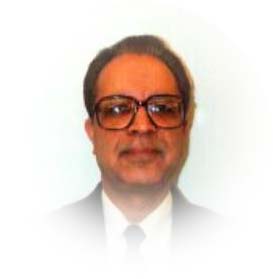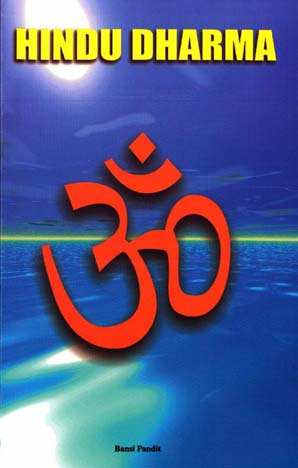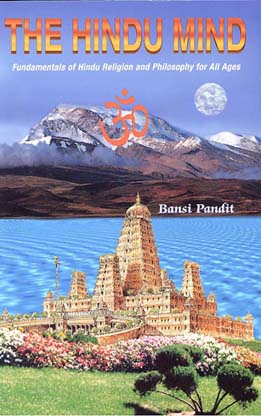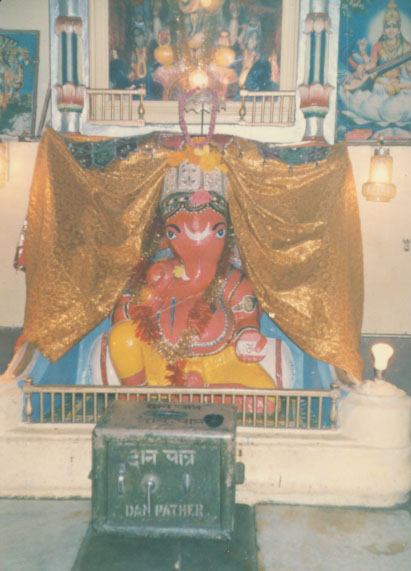|
Here is how to order these books: |
||||
| Item No | ISBN | Price each | Shipping | Total |
| Hindu Mind, soft cover | 0963479849 | $16 | $3 | $19 |
| Hindu Mind, hard cover | 0963479822 | $24 | $3 | $27 |
| Hindu Dharma, soft cover | 0963479830 | $9 | $3 | $12 |
|
Make check for the total amount payable |
||||
Bansi Pandit
Bansi Pandit is a nuclear engineer by profession. He has been a student of Vedanta and has been associated with the Vivekananda Vedanta Society since his college years. In 1981, he joined the Self-Realization Fellowship (founded in the United States by Parmahansa Yogãnanda) and completed a three-year home study course on yoga and meditation. He was initiated into Kriya Yoga in 1983 in the spiritual lineage of Parmahansa Yogãnanda, which he has been practicing under the spiritual guidance of the Self-Realization Fellowship. In 1988, he stayed at several ashrams in India practicing yoga and meditation.

Author of Hindu Mind & Hindu Dharma
Bansi Pandit is a writer and speaker on Hinduism and is listed in Who is Who in America. He has published numerous articles illustrating various aspects of Hindu religion and spirituality. He has taught Sunday school classes and has spoken at many temples, colleges, universities, and churches. He is a recommended speaker on Hinduism at the Council of World Parliament of Religions, Chicago, on inter-religious dialogue. He is a consultant to the Hindu Student Council (HSC) of America on Hindu philosophy and culture.
Bansi Pandit is the author of two books: The Hindu Mind: Fundamentals of Hindu Religion & Philosophy For All Ages and Hindu Dharma. Many scholars have declared these books to be treatises on Hindu religion and spirituality. Mr. Pandit is currently writing a new book to introduce Hindu spirituality to the Western world.
e-mail: hindumind@yahoo.com
Website: www.hindumind.org
Mailing List: True Essence of Hindu Religious Thought (TEOHIN)
Featured Collections
Hindu Dharma
The Hindu Temple Society of North America
(Sri Maha Vallabha Ganapati Devasthanam)
Even though Swami Vivekãnanda introduced and popularized the Hindu system of belief and philosophy in the North American Continent in 1893, the movement of Hindu Temples began and has gathered momentum only in the last quarter of this century. It is Lord Agastya, the pre-eminent sage now living in the astral world, who took the initiative to direct the establishment and growth of the New York Ganesha Temple and several other major temples in this land.
Lord Agastya when invoked by sincere devotees regularly through what is called Jîva Nãdî or Live Nãdî, communicates with His devotees in the form of letters. These sacred letters appear to the trained mediums only at the time of reading the sanctified ancient palmyara leaf scriptures. In August 1968, Dr. Alagappa Alagappan, a former U.N. Civil servant, was instructed to come and listen to the Nãdî readings. On the first day, he was informed that Lord Ganesha would take an abode in a city, the name of which began with the letter "N." When asked to come on the following day, he was informed as to how this temple would develop deep and abiding ties with the ancient heritage in India. The third time he was summoned to come, he was instructed to take on the task of building the Ganesha temple.

Every endeavor in Hinduism begins with the worship of Ganesha and it was indeed appropriate that the first major temple in this continent be built for Lord Ganesha. Dr. Alagappan proceeded to organize a team under the leadership of Mr. C. V. Narasimhan and established the Hindu Temple Society of North America on January 26, 1970. Generous financial and technical support were provided by the T.T. Devasthanam and the Endowments Department of the Government of Andhra Pradesh, India. Literally thousands of devotees contributed their time and money and the temple was consecrated by His Holiness Sri La Sri Pandrimalai Swamigal on July 4, 1977.
Since then the spectrum of worship has broadened at this temple to include the major Hindu forms of worship and practices prevailing in different parts of India. The Ganesha Temple which has taken the name of Maha Vallabha Ganpati Devasthanam has drawn devotees in ever widening concentric circles.
On September 21, 1995 more than eight thousand devotees came unannounced and had the privilege of offering milk to Lord Ganesha.
The New York Ganesha Temple has actively participated in securing temple architects, artisans and priests for several other temples in this continent. Since religion must be relevant to daily life, every endeavor is made to organize activities which would contribute to the welfare of devotees. Several cultural activities including instruction in dance, music and Indian languages have been undertaken. The auditorium and Kalyana Mandapam which will soon be in operation will provide some of the largest facilities of their kind in New York. Over the years one of the main objectives of the temple has been the organization of several growing social service programs in India.
Recently a program has been launched to disseminate substantive material pertaining to the Hindu religion and culture. A one hour weekly TV broadcast was initiated on December 23, 1995. Another major effort is to provide publications in simple and easily understandable English.
We are sponsoring publications such as this for the benefit of a wider and young readership. Our biannual newsletter which reaches more than 15 thousand readers also includes articles in popular terms explaining the various aspects of Hinduism.
Dr. Uma Mysorekar
President
Books by Bansi Pandit

CONTENTS OF THE BOOK:
The aim of this book is to present the fundamental concepts of all aspects of the Hindu religious, philosophical, and cultural heritage, the world’s oldest living tradition, in a simple and straightforward language for the readers of all ages. Thus, the basic concepts are exhaustively discussed and illustrated with the hope that once the reader has attained an understanding of the fundamentals of the Hindu heritage, he (or she) can proceed on his own accord to gain a better understanding of the higher teachings contained in other advanced books. Accordingly, this book includes the following features:
-
The book is divided in five parts (40 chapters, 448 pages). Part I through Parts IV discuss the fundamental concepts of all aspects of the Hindu religious, cultural and philosophical tradition.
-
Part V includes tables, figures, appendices, works cited, suggested readings for higher studies, glossary with pronunciation guide and an alphabetical index.
-
Each chapter is complete in itself and can be read independently of others. Cross-references to other sections of the book have been provided, as necessary, for a more comprehensive understanding of the contents
Here is what the experts and readers say about this book:
“...a remarkable and highly rewarding book. It is rational, objective, interesting, relevant and meaningful....”
Dr. T.K. Venkateswaran
Emeritus Professor of Hinduism,
University of Detroit.
“The Hindu Mind provides an excellent introduction to the historical, philosophical, ritualistic, social, and ethical dimensions of Hinduism. The major contribution of the book is that it shows the interconnections among these diverse dimensions.”
Rajeshwari V. Pandharipande
Associate Professor, University of Illinois, Urbana
“It is well-written, informative and timely...there is no other book available at that level where Hindu Americans can get answers to different questions about their religion and heritage....”
Subhash Kak
Professor, Lousiana State University.
“As a husband and father of two children, I have found The Hindu Mind to be an extraordinary book that my entire family can read, comprehend, and follow.”
H. D. Sharma
President, Hindu Temple of Greater Chicago.
“This is one of the best books that provides the present generation, especially the young and elite, with the genuine fundamental concepts of Hinduism.”
Dr. C. L. Shastri
Former Professor of Sanskrit,
University of Gujarat, India.
... excellent material...The book is veritably a treasure-house to anyone beginning to learn about the religion....”
Dr. Alagappa Alagappan
Honorary President, The Hindu Temple
Society of North America.
“The author skillfully uses American phrases to make one more familiar to the ideas
and concepts of Hinduism.”
Vikas Deshpande, Hindu Student Council, U.S.A.
“This book is an elixir, a cathartic, and an opiate simultaneously....”
India Light, News Journal, Illinois, U.S.A.
“I along with several of my students have benefited from The Hindu Mind. I find it an invaluable resource.”
W. Jay Wood
Associate Professor, Wheaton College, Illinois, U.S.A.
Thank you for having written such a concise and easy understandable book on a complex topic. It is a treasure of wisdom and knowledge to me."
Dr. A. Rolfes
Newrybar, Australia
“A very useful book for reference, being comprehensive in its scope. There is something for the reader of all ages.”
Bharatiya Vidya Bhavan, Bombay, India
“...an interesting and useful book. I think everyone---Hindu and non-Hindu---can benefit by reading this well-written book. It is required reading for all Hindus of all ages.”
Swami Brahmarupananda, Vedanta Society
“...provides a well-crafted and complete overview of the fundamental concepts of Hinduism. This work is an invaluable resource.”
Hinduism Today, U.S.A.
“...lucidly explains Hinduism in a nutshell.”
News India-Times, New York.
“The book is packed with excellent material...is being sold in the Temple and almost everyone who has bought it has appreciated the contents.”
Dr. Uma Mysorekar
President, The Hindu Temple Society of North America
“I have read many books about Hinduism and Indian culture, but this is the best one I have ever encountered. It explains many issues that are otherwise confusing to an Indian, such as myself, who was born and aised in America.”
Deepa Patel, Burlington, New Jersey.
“A wonderful book, easy to understand.”
Nisha Patel, 13-years old, Voorthees, NJ.
“Nothing surpasses the research assembled in this book.”
Dinesh Kampani, Hollywood, CA.
“This book has the depth of knowledge which every Hindu and non-Hindu can utilize and gain from.”
Abnash Narula, Hari Om Mandhir, IL
“It combines erudition with simplicity of style that is rare among Indian authors of books on Hinduism.”
Bandana Purkayastha, Weatogue, CT.

Hindu Dharma
A New Comprehensive Guide to Hindu Way of Life
ISBN: 0-9634798-3-0, soft cover, 120 pp. plus nine color pictures of popular Hindu deities
Hindu Dharma explains the symbolism of the Hindu deities and includes nine beautiful color pictures of the popular Hindu deities. These pictures can be used for daily puja (worship) in the home shrines by the devotees. The book also includes the historic address of Swami Vivekãnanda on Hinduism at the 1893 World Parliament of Religions in Chicago. The book explains:
-
What are the essential features of the Hindu way of life?
-
What is the Hindu concept of a harmonious family?
-
What is the Hindu vision of a harmonious world?
-
What are the responsibilities of parents, teachers and elders in Hindu culture?
-
What is the Hindu mannerism and etiquette towards elders?
-
What is the Hindu definition of right and wrong?
-
What is the daily routine of a devout Hindu?
-
How can today’s youth and young adults benefit from Hindu religious and spiritual teachings?
-
What is the message of Vedas for mankind?
-
What is the Hindu spiritual vision of legal, political and economic systems?
-
Are the Hindu religious doctrines relevant to the modern world?
-
What contribution have Hindus made to the world culture?
-
What exactly did Swami Vivekãnanda say at the 1893 World Parliament of Religions in Chicago that helped the Western world to understand and finally appreciate the Hindu religious tradition?
-
Why do Hindus call their religion a universal religion (Sanãtana Dharma)?

EXPLORE HINDUISM
Bansi Pandit
Hinduism is the oldest living religious tradition in the world. Explore Hinduismis a concise but well-rounded introduction to the variety of beliefs and practices, and describes how Hindus think, act and practice their faith in the modern world. Most importantly, it illuminates the 'soul' of Hinduism, its spirituality.
Bansi Pandit has an excellent grasp of the depth and breadth of Hinduism and his style is readable, making Explore Hinduism simple and undaunting for those approaching this religion for the first time.
This book is recommended for Key Stage 2 and 3 Religious Education and as background reading for all teachers who need to be aware of Hindu beliefs and religious practices.
Published by Explore Books, an imprint of Heart of Albion Press.
ISBN 1 872883 81 8. NEW October 2005.
demy 8vo (215 x 138 mm), 187 + viii pages, 10 b&w photos; 12 line drawings; 6 diagrams, paperback
£12.95
Source: http://www.hoap.co.uk/explore.htm#ExHi
Hindu Deities
Just as a single force in space can be mathematically conceived as having various spatial components, the Supreme Being or God, the personal form of the Ultimate Reality, is conceived by Hindus as having various aspects. A Hindu deity (god or goddess; note small g) represents a particular aspect of the Supreme Being. For example, Saraswati represents the learning and knowledge aspect of the Supreme Being. Thus, if a Hindu wants to pray for acquiring knowledge and understanding, he prays to Saraswati. Just as sunlight cannot have a separate and independent existence from the sun itself, a Hindu deity does not have a separate and independent existence from the Supreme Being. Thus, Hindu worship of deities is monotheistic polytheism and not simple polytheism.
having various spatial components, the Supreme Being or God, the personal form of the Ultimate Reality, is conceived by Hindus as having various aspects. A Hindu deity (god or goddess; note small g) represents a particular aspect of the Supreme Being. For example, Saraswati represents the learning and knowledge aspect of the Supreme Being. Thus, if a Hindu wants to pray for acquiring knowledge and understanding, he prays to Saraswati. Just as sunlight cannot have a separate and independent existence from the sun itself, a Hindu deity does not have a separate and independent existence from the Supreme Being. Thus, Hindu worship of deities is monotheistic polytheism and not simple polytheism.
Hindus declare that there is only one Supreme Being and He is the God of all religions. There is no "other God." Thus the Biblical Commandment "Thou shalt have no other God before me," really means, "Thou shalt not deny the Ultimate Reality or worship any power other than the Ultimate Reality."
Hindus view cosmic activity of the Supreme Being as comprised of three tasks: creation, preservation, and dissolution and recreation. Hindus associate these three cosmic tasks with the three deities, Brahma, Vishnu and Shiva. Lord Brahma brings forth the creation and represents the creative principle of the Supreme Being. Lord Vishnu maintains the universe and represents the eternal principle of preservation. Lord Shiva represents the principle of dissolution and recreation. These three deities together form the Hindu Trinity.
One must clearly understand that Brahma, Vishnu and Shiva are not three independent deities. They represent the same power (the Supreme Being), but in three different aspects. Just as a man may be called a doctor, father or husband based upon the tasks he performs, the Supreme Being is called Brahma, Vishnu or Shiva when conceived as performing the three different cosmic tasks of creation, preservation, and dissolution/recreation. "The oneness of the three gods Brahma, Vishnu and Shiva is brought out by the mystic symbol AUM where 'A' represents Vishnu, 'U' Shiva and 'M' Brahma."
Hindu religion is often labeled as a religion of 330 million gods. This misunderstanding arises when people fail to grasp the symbolism of the Hindu pantheon. According to the Hindu scriptures, living beings are not apart from God, since He lives in each and every one of them in the form of atman (BG 10.39). Thus each living being is a unique manifestation of God. In ancient times it was believed that there were 330 million living beings. This gave rise to the idea of 330 million deities or gods. Actually, this vast number of gods could not have been possibly worshipped, since 330 million names could not have been designed for them. The number 330 million was simply used to give a symbolic expression to the fundamental Hindu doctrine that God lives in the hearts of all living beings.

- Bansi Pandit



